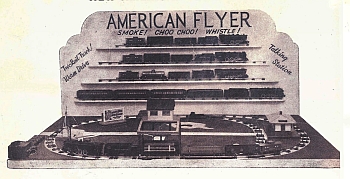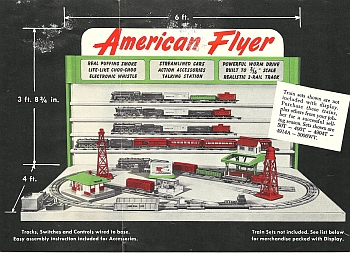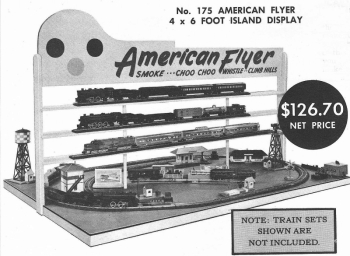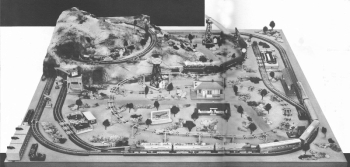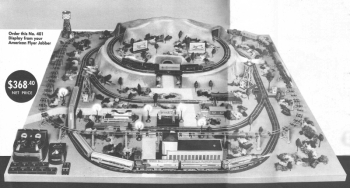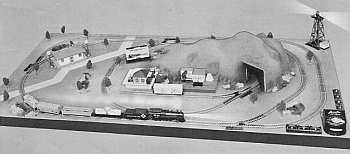Layout Displays
History of the Layout Displays
Beginning in 1949, Gilbert prepared ready to operate layouts for their dealers use in displaying the latest American Flyer Trains and Accessories. Many of the changes that took place from year to year was simply the substitution of newly introduced accessories for older accessories. In some cases the display layout included the trains pictured but in many it did not. The pitch made to dealers was that this was an item that would "liquidate" itself. The dealers were told that they could sell the American Flyer products from the display at list price after the Christmas selling season and then sell the display to a "model railroad hobbyist." In "Flyer Facts" contained in the American Flyer Collectors Column in the July/August 2001 S-Gaugian, Robert Tufts notes that most dealers had to sell the accessories contained in the displays at a discount because they were used merchandise and didn't make a lot of profit on the sale of what was left of the display. Such sales, however, probably account for at least some of the original displays that exist today. While most of the layouts were produced by the Gilbert Display Department, at least some, especially the early layouts, were produced by subcontractors.
There is a page for each layout which contains a catalog illustration of the display layout where one is available, a list of contents if stated in the catalog, and a downloadable track plan for use with RRTrack software along with illustrations of the trackplan including a 3D view.
Track Plans
The track plans presented in this section are simply my best estimate based on the catalog illustrations. I attempted to identify the individual track sections by noting double ties that would be found where track sections were joined. The accessories were identified based on the listing, where available, and placed on the layout based on the illustrations. Also, the Gilbert factory was know to bend track to custom radii on occasion. For these reasons, there may be some errors in the plans. Feel free to bring these errors to my attention.
A final point to note is that RRTrack software does not have a
library for American Flyer S gauge Pikemaster track, so these
sections were approximated on S gauge Pikemaster plans by using
custom sections from the Gargraves S gauge library. All HO plans,
including Pikemaster plans, were developed using the Atlas 100 HO
library, as the radius of Atlas and Pikemaster HO track were
identical.

